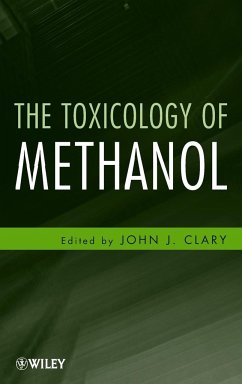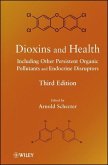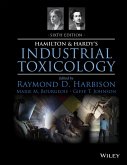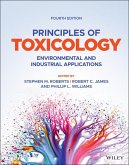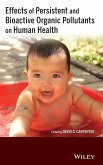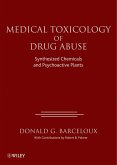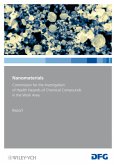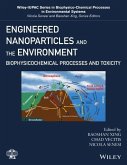John J. Clary
Methanol
John J. Clary
Methanol
- Gebundenes Buch
- Merkliste
- Auf die Merkliste
- Bewerten Bewerten
- Teilen
- Produkt teilen
- Produkterinnerung
- Produkterinnerung
The Toxicology of Methanol presents a single source of information and an understanding of the toxicity of methanol from animal data, potential environmental effects as well as human effects. The animal data, which goes to making up the majority of the data on the toxicity of methanol and the mechanism of action, is reviewed as it relates to the potential toxicity in humans.
Andere Kunden interessierten sich auch für
![Dioxins and Health Including Other Persistent Organic Pollutants and Endocrine Disruptors Dioxins and Health Including Other Persistent Organic Pollutants and Endocrine Disruptors]() Dioxins and Health Including Other Persistent Organic Pollutants and Endocrine Disruptors167,99 €
Dioxins and Health Including Other Persistent Organic Pollutants and Endocrine Disruptors167,99 €![Hamilton and Hardy's Industrial Toxicology Hamilton and Hardy's Industrial Toxicology]() Raymond D. HarbisonHamilton and Hardy's Industrial Toxicology200,99 €
Raymond D. HarbisonHamilton and Hardy's Industrial Toxicology200,99 €![Principles of Toxicology Principles of Toxicology]() Principles of Toxicology191,99 €
Principles of Toxicology191,99 €![Effects of Persistent and Bioactive Organic Pollutants on Human Health Effects of Persistent and Bioactive Organic Pollutants on Human Health]() David O. CarpenterEffects of Persistent and Bioactive Organic Pollutants on Human Health150,99 €
David O. CarpenterEffects of Persistent and Bioactive Organic Pollutants on Human Health150,99 €![Medical Toxicology of Drug Abuse Medical Toxicology of Drug Abuse]() Donald G. BarcelouxMedical Toxicology of Drug Abuse219,99 €
Donald G. BarcelouxMedical Toxicology of Drug Abuse219,99 €![Nanomaterials Nanomaterials]() Nanomaterials42,99 €
Nanomaterials42,99 €![Engineered Nanoparticles and the Environment Engineered Nanoparticles and the Environment]() Engineered Nanoparticles and the Environment210,99 €
Engineered Nanoparticles and the Environment210,99 €-
-
-
The Toxicology of Methanol presents a single source of information and an understanding of the toxicity of methanol from animal data, potential environmental effects as well as human effects. The animal data, which goes to making up the majority of the data on the toxicity of methanol and the mechanism of action, is reviewed as it relates to the potential toxicity in humans.
Hinweis: Dieser Artikel kann nur an eine deutsche Lieferadresse ausgeliefert werden.
Hinweis: Dieser Artikel kann nur an eine deutsche Lieferadresse ausgeliefert werden.
Produktdetails
- Produktdetails
- Verlag: Wiley & Sons
- 1. Auflage
- Seitenzahl: 304
- Erscheinungstermin: 29. Januar 2013
- Englisch
- Abmessung: 240mm x 161mm x 21mm
- Gewicht: 624g
- ISBN-13: 9780470317594
- ISBN-10: 0470317590
- Artikelnr.: 36395213
- Herstellerkennzeichnung
- Libri GmbH
- Europaallee 1
- 36244 Bad Hersfeld
- gpsr@libri.de
- Verlag: Wiley & Sons
- 1. Auflage
- Seitenzahl: 304
- Erscheinungstermin: 29. Januar 2013
- Englisch
- Abmessung: 240mm x 161mm x 21mm
- Gewicht: 624g
- ISBN-13: 9780470317594
- ISBN-10: 0470317590
- Artikelnr.: 36395213
- Herstellerkennzeichnung
- Libri GmbH
- Europaallee 1
- 36244 Bad Hersfeld
- gpsr@libri.de
JOHN J. CLARY is President of Bio Risk, a toxicology consulting firm. Previously, he worked for two U.S. government research laboratories, managed the toxicology groups of DuPont and Hoechst Celanese, and served as Director of Toxicology for Dow Corning and Celanese. Dr. Clary has authored sixty-five articles.
Preface xiii
Contributors xv
1 Methanol Production and Markets: Past, Present, and Future 1
Gregory A. Dolan
References 9
2 Methanol: Fate and Transport in the Environment 11
Rula A. Deeb, Todd L. Anderson, Michael C. Kavanaugh, and Lauren A. Kell
2.1 Introduction 11
2.2 Partitioning of Methanol in the Environment 16
2.3 Fate and Transport of Methanol in the Environment 22
2.4 Methanol Additives 37
2.5 Conclusions 40
References 40
3 Human Toxicity 47
John J. Clary
3.1 Introduction 47
3.2 Exposure 48
3.3 Metabolism in Humans 50
3.4 History of Human Toxicity 54
3.5 Controlled Human Studies 60
3.6 In Utero Exposure 62
3.7 Repeat Inhalation Exposure 63
3.8 Management of Methanol Poisoning 64
3.9 Conclusions 66
References 67
4 General Animal and Aquatic Toxicity 73
John J. Clary
4.1 Introduction 73
4.2 Acute Toxicity 74
4.3 Irritation 86
4.4 Sensitization 87
4.5 Repeat Exposure-Inhalation 87
4.6 Repeat Exposure-Oral 94
4.7 Repeat Exposure-Dermal 96
4.8 Aquatic Toxicity 96
4.9 Conclusion 99
References 100
5 Developmental and Reproductive Toxicology of Methanol 107
John M. Rogers, Jeffrey S. Gift, and Stanley Barone, Jr.
5.1 Introduction 107
5.2 Reproductive Toxicity 108
5.3 Developmental Toxicity 110
5.4 Conclusions 136
Disclaimer 139
References 139
6 Exploring Differences Between PBPK Models of Methanol Disposition in Mice
and Humans: Important Lessons Learned 145
Thomas B. Starr
6.1 Background 145
6.2 Are Humans More or Less Sensitive than Mice to the Toxic Effects of
Methanol? 148
6.3 Are the Two Models' Predictions of Human Blood Methanol Concentrations
at Steady State Consistent with Each Other? 153
6.4 Are the Values of Key Human Metabolism Parameters Consistent with Those
in the Published Scientific Literature? 155
6.5 Shouldn't the Possibility of Systematic Bias be Considered Carefully
During the Model Fitting and Parameter Estimation Process? 160
6.6 Is "Visual Optimization" an Adequate Technique for Estimating PBPK
Model Parameters? 161
6.7 When Human Data are Available, Shouldn't they be Utilized in Making an
Objective Comparison of Model-Specific Predictions? 163
6.8 Summary of Lessons Learned 164
References 165
7 Oxidative Stress and Species Differences in the Metabolism, Developmental
Toxicity, and Carcinogenic Potential of Methanol and Ethanol 169
Peter G. Wells, Gordon P. McCallum, Lutfiya Miller, Michelle Siu, and J.
Nicole Sweeting
7.1 Introduction 169
7.2 Species Differences in Methanol Metabolism 179
7.3 Species and Strain Differences in Methanol Toxicity 191
7.4 Oxidative Stress 213
7.5 Conclusions 237
Acknowledgment 238
References 238
8 Methanol and Cancer 255
John J. Clary
8.1 Introduction 255
8.2 Rodent Bioassay 256
8.3 Possible Mechanisms 270
8.4 Human Cancer Data 276
8.5 Conclusion 276
References 277
Index 283
Contributors xv
1 Methanol Production and Markets: Past, Present, and Future 1
Gregory A. Dolan
References 9
2 Methanol: Fate and Transport in the Environment 11
Rula A. Deeb, Todd L. Anderson, Michael C. Kavanaugh, and Lauren A. Kell
2.1 Introduction 11
2.2 Partitioning of Methanol in the Environment 16
2.3 Fate and Transport of Methanol in the Environment 22
2.4 Methanol Additives 37
2.5 Conclusions 40
References 40
3 Human Toxicity 47
John J. Clary
3.1 Introduction 47
3.2 Exposure 48
3.3 Metabolism in Humans 50
3.4 History of Human Toxicity 54
3.5 Controlled Human Studies 60
3.6 In Utero Exposure 62
3.7 Repeat Inhalation Exposure 63
3.8 Management of Methanol Poisoning 64
3.9 Conclusions 66
References 67
4 General Animal and Aquatic Toxicity 73
John J. Clary
4.1 Introduction 73
4.2 Acute Toxicity 74
4.3 Irritation 86
4.4 Sensitization 87
4.5 Repeat Exposure-Inhalation 87
4.6 Repeat Exposure-Oral 94
4.7 Repeat Exposure-Dermal 96
4.8 Aquatic Toxicity 96
4.9 Conclusion 99
References 100
5 Developmental and Reproductive Toxicology of Methanol 107
John M. Rogers, Jeffrey S. Gift, and Stanley Barone, Jr.
5.1 Introduction 107
5.2 Reproductive Toxicity 108
5.3 Developmental Toxicity 110
5.4 Conclusions 136
Disclaimer 139
References 139
6 Exploring Differences Between PBPK Models of Methanol Disposition in Mice
and Humans: Important Lessons Learned 145
Thomas B. Starr
6.1 Background 145
6.2 Are Humans More or Less Sensitive than Mice to the Toxic Effects of
Methanol? 148
6.3 Are the Two Models' Predictions of Human Blood Methanol Concentrations
at Steady State Consistent with Each Other? 153
6.4 Are the Values of Key Human Metabolism Parameters Consistent with Those
in the Published Scientific Literature? 155
6.5 Shouldn't the Possibility of Systematic Bias be Considered Carefully
During the Model Fitting and Parameter Estimation Process? 160
6.6 Is "Visual Optimization" an Adequate Technique for Estimating PBPK
Model Parameters? 161
6.7 When Human Data are Available, Shouldn't they be Utilized in Making an
Objective Comparison of Model-Specific Predictions? 163
6.8 Summary of Lessons Learned 164
References 165
7 Oxidative Stress and Species Differences in the Metabolism, Developmental
Toxicity, and Carcinogenic Potential of Methanol and Ethanol 169
Peter G. Wells, Gordon P. McCallum, Lutfiya Miller, Michelle Siu, and J.
Nicole Sweeting
7.1 Introduction 169
7.2 Species Differences in Methanol Metabolism 179
7.3 Species and Strain Differences in Methanol Toxicity 191
7.4 Oxidative Stress 213
7.5 Conclusions 237
Acknowledgment 238
References 238
8 Methanol and Cancer 255
John J. Clary
8.1 Introduction 255
8.2 Rodent Bioassay 256
8.3 Possible Mechanisms 270
8.4 Human Cancer Data 276
8.5 Conclusion 276
References 277
Index 283
Preface xiii
Contributors xv
1 Methanol Production and Markets: Past, Present, and Future 1
Gregory A. Dolan
References 9
2 Methanol: Fate and Transport in the Environment 11
Rula A. Deeb, Todd L. Anderson, Michael C. Kavanaugh, and Lauren A. Kell
2.1 Introduction 11
2.2 Partitioning of Methanol in the Environment 16
2.3 Fate and Transport of Methanol in the Environment 22
2.4 Methanol Additives 37
2.5 Conclusions 40
References 40
3 Human Toxicity 47
John J. Clary
3.1 Introduction 47
3.2 Exposure 48
3.3 Metabolism in Humans 50
3.4 History of Human Toxicity 54
3.5 Controlled Human Studies 60
3.6 In Utero Exposure 62
3.7 Repeat Inhalation Exposure 63
3.8 Management of Methanol Poisoning 64
3.9 Conclusions 66
References 67
4 General Animal and Aquatic Toxicity 73
John J. Clary
4.1 Introduction 73
4.2 Acute Toxicity 74
4.3 Irritation 86
4.4 Sensitization 87
4.5 Repeat Exposure-Inhalation 87
4.6 Repeat Exposure-Oral 94
4.7 Repeat Exposure-Dermal 96
4.8 Aquatic Toxicity 96
4.9 Conclusion 99
References 100
5 Developmental and Reproductive Toxicology of Methanol 107
John M. Rogers, Jeffrey S. Gift, and Stanley Barone, Jr.
5.1 Introduction 107
5.2 Reproductive Toxicity 108
5.3 Developmental Toxicity 110
5.4 Conclusions 136
Disclaimer 139
References 139
6 Exploring Differences Between PBPK Models of Methanol Disposition in Mice
and Humans: Important Lessons Learned 145
Thomas B. Starr
6.1 Background 145
6.2 Are Humans More or Less Sensitive than Mice to the Toxic Effects of
Methanol? 148
6.3 Are the Two Models' Predictions of Human Blood Methanol Concentrations
at Steady State Consistent with Each Other? 153
6.4 Are the Values of Key Human Metabolism Parameters Consistent with Those
in the Published Scientific Literature? 155
6.5 Shouldn't the Possibility of Systematic Bias be Considered Carefully
During the Model Fitting and Parameter Estimation Process? 160
6.6 Is "Visual Optimization" an Adequate Technique for Estimating PBPK
Model Parameters? 161
6.7 When Human Data are Available, Shouldn't they be Utilized in Making an
Objective Comparison of Model-Specific Predictions? 163
6.8 Summary of Lessons Learned 164
References 165
7 Oxidative Stress and Species Differences in the Metabolism, Developmental
Toxicity, and Carcinogenic Potential of Methanol and Ethanol 169
Peter G. Wells, Gordon P. McCallum, Lutfiya Miller, Michelle Siu, and J.
Nicole Sweeting
7.1 Introduction 169
7.2 Species Differences in Methanol Metabolism 179
7.3 Species and Strain Differences in Methanol Toxicity 191
7.4 Oxidative Stress 213
7.5 Conclusions 237
Acknowledgment 238
References 238
8 Methanol and Cancer 255
John J. Clary
8.1 Introduction 255
8.2 Rodent Bioassay 256
8.3 Possible Mechanisms 270
8.4 Human Cancer Data 276
8.5 Conclusion 276
References 277
Index 283
Contributors xv
1 Methanol Production and Markets: Past, Present, and Future 1
Gregory A. Dolan
References 9
2 Methanol: Fate and Transport in the Environment 11
Rula A. Deeb, Todd L. Anderson, Michael C. Kavanaugh, and Lauren A. Kell
2.1 Introduction 11
2.2 Partitioning of Methanol in the Environment 16
2.3 Fate and Transport of Methanol in the Environment 22
2.4 Methanol Additives 37
2.5 Conclusions 40
References 40
3 Human Toxicity 47
John J. Clary
3.1 Introduction 47
3.2 Exposure 48
3.3 Metabolism in Humans 50
3.4 History of Human Toxicity 54
3.5 Controlled Human Studies 60
3.6 In Utero Exposure 62
3.7 Repeat Inhalation Exposure 63
3.8 Management of Methanol Poisoning 64
3.9 Conclusions 66
References 67
4 General Animal and Aquatic Toxicity 73
John J. Clary
4.1 Introduction 73
4.2 Acute Toxicity 74
4.3 Irritation 86
4.4 Sensitization 87
4.5 Repeat Exposure-Inhalation 87
4.6 Repeat Exposure-Oral 94
4.7 Repeat Exposure-Dermal 96
4.8 Aquatic Toxicity 96
4.9 Conclusion 99
References 100
5 Developmental and Reproductive Toxicology of Methanol 107
John M. Rogers, Jeffrey S. Gift, and Stanley Barone, Jr.
5.1 Introduction 107
5.2 Reproductive Toxicity 108
5.3 Developmental Toxicity 110
5.4 Conclusions 136
Disclaimer 139
References 139
6 Exploring Differences Between PBPK Models of Methanol Disposition in Mice
and Humans: Important Lessons Learned 145
Thomas B. Starr
6.1 Background 145
6.2 Are Humans More or Less Sensitive than Mice to the Toxic Effects of
Methanol? 148
6.3 Are the Two Models' Predictions of Human Blood Methanol Concentrations
at Steady State Consistent with Each Other? 153
6.4 Are the Values of Key Human Metabolism Parameters Consistent with Those
in the Published Scientific Literature? 155
6.5 Shouldn't the Possibility of Systematic Bias be Considered Carefully
During the Model Fitting and Parameter Estimation Process? 160
6.6 Is "Visual Optimization" an Adequate Technique for Estimating PBPK
Model Parameters? 161
6.7 When Human Data are Available, Shouldn't they be Utilized in Making an
Objective Comparison of Model-Specific Predictions? 163
6.8 Summary of Lessons Learned 164
References 165
7 Oxidative Stress and Species Differences in the Metabolism, Developmental
Toxicity, and Carcinogenic Potential of Methanol and Ethanol 169
Peter G. Wells, Gordon P. McCallum, Lutfiya Miller, Michelle Siu, and J.
Nicole Sweeting
7.1 Introduction 169
7.2 Species Differences in Methanol Metabolism 179
7.3 Species and Strain Differences in Methanol Toxicity 191
7.4 Oxidative Stress 213
7.5 Conclusions 237
Acknowledgment 238
References 238
8 Methanol and Cancer 255
John J. Clary
8.1 Introduction 255
8.2 Rodent Bioassay 256
8.3 Possible Mechanisms 270
8.4 Human Cancer Data 276
8.5 Conclusion 276
References 277
Index 283

